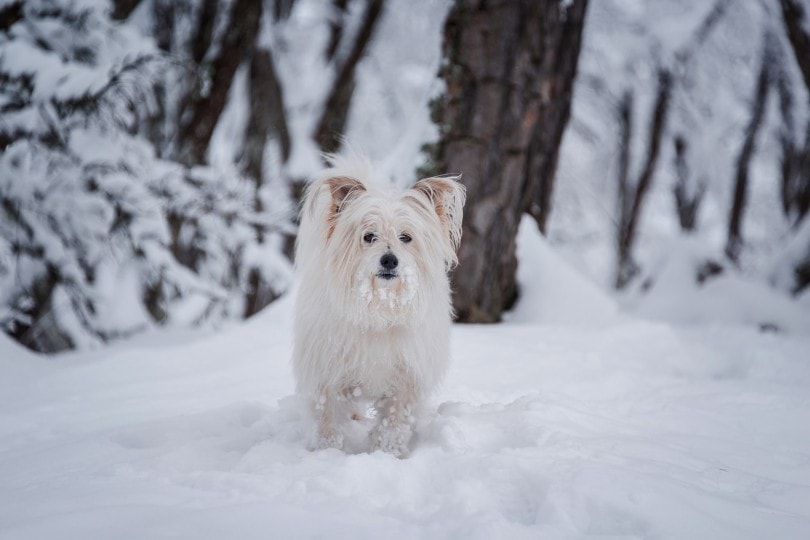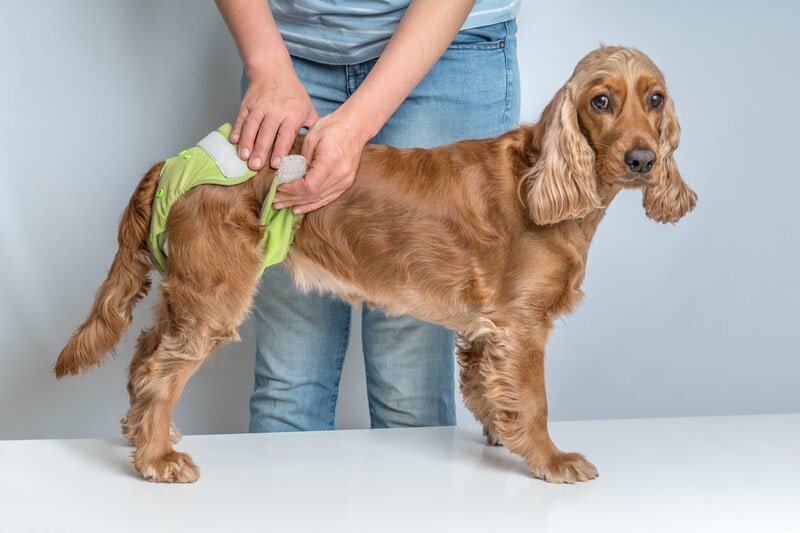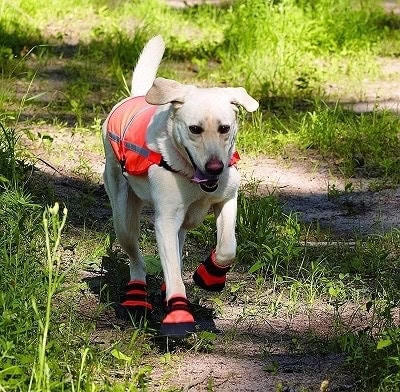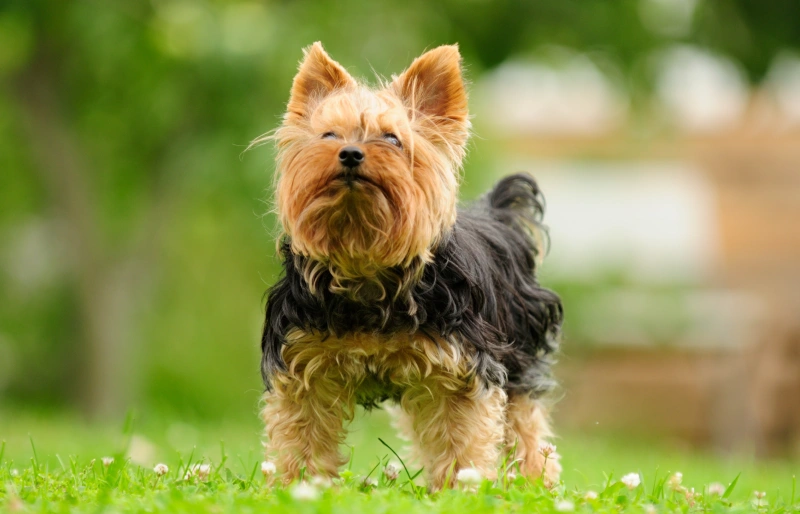White Yorkie Dog Growth & Weight Chart

Updated on

Typically, it isn’t possible to come across a purebred Yorkshire Terrier with white fur. These dogs are commonly bred and born with only specific color combinations. Black and tan is the most common, followed by blue and gold. There can be combinations of these two, but white does not usually come into play.
The capacity for a Yorkie to be all white comes down to genetics. So, when looking for purebred white Yorkies, ask yourself: Are you looking for an entirely white Yorkie, or can they have a coat of mixed colors? Instead of being all white, is it okay if they are a mixture of the typical colors with a bit of white?
Whatever the resulting color of your Yorkie puppy, we are here to help define their growth stages, from newborn pups to full-grown adults. If you want to know whether your white Yorkie dog is on track, check out the graphs and growth descriptions here.
Facts About the White Yorkie Dog
A purebred Yorkshire Terrier can be entirely white, but this only happens when they are born an albino. Not only will their fur be completely white, but their skin, footpads, and nose will also all be a pale pink color, and they’ll have pink or red irises.
The other two ways to get a white Yorkie are the continued breeding of particular dogs together or a mixed breed added to the purebred Yorkie line somewhere along the way.

The first of the two involves breeding a particular genetic strand of Yorkie with the “piebald gene” that might bring in white spotting. Otherwise, it is almost impossible for a purebred Yorkie to have any white on them.
When a Yorkie is firstborn, they will only weigh between 3 and 5 ounces. The first 8 weeks of their life are the most influential in their growth patterns. Within the first week alone, they have often tripled in size, at least to be over 1 pound.
White Yorkie Puppy Growth and Weight Chart
When you adopt a Yorkie at 8 weeks old, they should weigh between 12 and 32 ounces and only stand a few inches high. They are adorable and will happily stay puppy-sized for most of their lives. Use these graphs to track your Yorkie’s growth process. But don’t worry if they are not right on track, since each dog is different and will have different growth spurts.
White Yorkie Puppy Growth and Weight Chart (Male)
| Weight Range | Height Range | |
| 8 weeks | 12–32 oz. | 3”–3.25” |
| 9 weeks | 13–35 oz. | 3.25”–3.5” |
| 10 weeks | 14–38 oz. | 3.5”–4” |
| 11 weeks | 15–42 oz. | 3.75”–4.25” |
| 3 months | 16–45 oz. | 4.5”–4.75” |
| 4 months | 20–59 oz. | 4.5”–5.25” |
| 5 months | 24–70 oz. | 4.75”–5.5” |
| 6 months | 26–78 oz. | 5.25”–6” |
| 7 months | 27–80 oz. | 5.5”–6.25” |
| 8 months | 29–82 oz. | 5.75”–6.5” |
| 9 months | 30–85 oz. | 6.25”–7” |
| 10 months | 31–88 oz. | 6.75”–7.5” |
| 11 months | 32–91 oz. | 7”–8” |
| 1 year | 33–94 oz. | 7.5”–8.25” |
| 2 years | 34–98 oz. | 8”–9” |
White Yorkie Puppy Growth and Weight Chart (Female)
| Weight Range | Height Range | |
| 8 weeks | 12–32 oz. | 3”–3.25” |
| 9 weeks | 13–35 oz. | 3.25”–3.5” |
| 10 weeks | 14–38 oz. | 3.5”–4” |
| 11 weeks | 15–42 oz. | 3.75”–4.25” |
| 3 months | 16–45 oz. | 4.5”–4.75” |
| 4 months | 20–59 oz. | 4.5”–5.25” |
| 5 months | 24–70 oz. | 4.75”–5.5” |
| 6 months | 26–78 oz. | 5.25”–6” |
| 7 months | 27–80 oz. | 5.5”–6.25” |
| 8 months | 29–82 oz. | 5.75”–6.5” |
| 9 months | 30–85 oz. | 6.25”–7” |
| 10 months | 31–88 oz. | 6.75”–7.5” |
| 11 months | 32–91 oz. | 7”–8” |
| 1 year | 33–94 oz. | 7.5”–8.25” |
| 2 years | 34–98 oz. | 8”–9” |
You need to take good care of your pet while they are growing, so you can use our calculator tool to help you know how much to feed your pup and keep their well-being:
The exact amount of calories an individual animal needs to maintain a healthy weight is variable and influenced by many factors including genetics, age, breed, and activity level. This tool is meant to be used only as a guideline for healthy individuals and does not substitute veterinary advice
White Yorkie Dog Growth Stages
The first year of growth is the most important for any dog. They will grow exponentially faster than at any other point in their lives. Dogs, including Yorkies, typically reach their adult size at about 18 months old. Sometimes, males will continue to grow past this until their second year. Yorkies will go through all sorts of growth stages as they come of age.
8-Week-Old (2 Months) White Yorkie
An 8-week-old puppy should be the earliest age that you can adopt a dog. Before this point in time, they are too vulnerable and have yet to be weaned from their mothers. If you suspect that your dog is not 8 weeks old, you should not adopt them. Being weaned too early can cause health, temperament, and growth issues in the future.
Until this point in your Yorkie’s life, they have probably not met anyone other than their breeder and family. Use this early time in your dog’s life to imprint certain behaviors on them.
Yorkies between 8 and 10 weeks old can experience permanent feelings of fear and go through another similar stage at 16 weeks old. This time is the most important window that you have to begin to carefully introduce your dog to as many new situations and training sessions as possible. Take them on car rides, go outside to parks, and allow them to meet new dogs and people.
12-Week-Old (3 Months) White Yorkie
Yorkies will typically begin to lose their baby teeth and start growing their adult teeth around 3 or 4 months. They should be getting used to being around other animals and getting introduced to new people. Ensure that you do all of this slowly and carefully, so they do not experience lasting fear.
At about 4 or 5 months old, female Yorkies can be spayed. It is also this same period that your Yorkie should be taken to the groomer for the first time. They need to get the hair cleaned out of their ears and from around their eyes. Doing so this early also helps them get accustomed to a groomer.
6-Month-Old White Yorkie

Once a Yorkie hits 6 months old, they begin what is known as the adolescence stage. Male Yorkies can be neutered around this age or within the next couple of months. Yorkies will be incredibly energetic around this age and will typically be looking to settle into more of a routine.
Yorkies are dogs of comfort, and they want to know that they are safe. At about this age, you should be ensuring their comfort zones so they will behave better in adulthood. Start taking them to obedience classes if you haven’t already.
12-Month-Old (1 Year) White Yorkie
A Yorkie will typically stop growing at about 1 year old, or 12 months. They begin to slow down between months 9 and 12 and start to calm down a bit. Yorkies that are 1 year old will typically look similar to how they will for the remainder of their life.
Continue to work on the socialization of your Yorkie even as they move into adulthood. Yorkies are resistant to change once they hit about 2 years old. If they have not already grown accustomed to having other dogs and pets around, they will be territorial and might even try to be aggressive.
When Do White Yorkies Stop Growing?
Yorkies are such small dogs that they often do not continue to grow past the 12-month mark. Once they hit 1 year, your dog will continue to look like they do now. Yorkies do not tend to fill out more past this age, unlike larger, more muscular dogs.
Yorkshire Terrier’s growth typically slows down between the age of 9 and 10 months old. The last couple of months in the year will see much less substantial jumps in weight and height than when they were little puppies.
Yorkie puppies can be quite excitable. As they age, they are likely to calm down. They generally reach more adult-like maturity between the ages of 2 and 3 years old.
How Does Neutering/Spaying Affect My Dog’s Growth?
You need to be careful when you decide to spay or neuter your dog. Doing it too early is much more detrimental than holding off. Ask your vet about the proper time to get the procedure done, and wait until at least then. Keep them safely away from other dogs until they can have the surgery done.
It is best for both males and females to be spayed or neutered before they are 1 year old. For females, you should spay them before their first heat cycle. It is generally safe to do so when they are either 4 or 5 months old. Doing so can also decrease their chance of cancer.
When it comes to males, you should wait several more months until they are at least 6 months old. Getting it done too early could stunt their growth or cause them to grow unevenly.
Dangers of Growing Too Quickly or Stunted Growth
Growing too quickly in a dog’s formative puppy months will be detrimental to their long-term figure and health. It is often caused by overfeeding your puppy or switching them to adult dog food too early.
Although you can free-feed a puppy younger than 3 months old, you should begin a more structured routine once they hit that age or 2.5 pounds. They should not switch to adult dog food until they are at least 9 months old, though 1 year is better.
Growing too quickly or stunted growth can result in health conditions like hip dysplasia, osteochondrosis, skeletal abnormalities, and more.
Conclusion
It is best to observe your dog and care for them properly in their early, formative months. Not doing this can end up hurting them for the rest of their lives. Take them to the vet for check-ups if you ever have any worries. However, socializing them, giving them the right food, and getting them the exercise they need should be all you need to do to ensure their continued health.
Featured Image Credit: Ales Krivec, Unsplash














